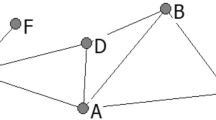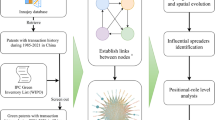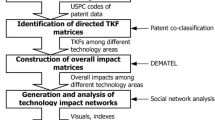Abstract
Research activities on solar energy has been growing and use of patents becomes an important innovation source for many types of studies. This paper aims to analyze solar photovoltaic (PV) patents and describes its assignees cooperation profile. PV patents based on IPC Green Inventory code were selected from 1990 to 2014, filtered out co-ownership patents and use social network analysis (SNA) to find PV technology development networks. Main findings are an increase of patents assignees over the years and a general concern for develop technologies “Devices adapted for the conversion radiation energy into electrical energy”, “Assemblies of a plurality of solar cells” and “Silicon; single-crystal growth”. SNA enabled to identify four countries clusters that presented cooperation behavior and shared similar concerns in PV technology development. The USA, China, Spain and Korea were main countries of each cluster. Furthermore, through network statistics, it implied that a country that had more patents was not the most important on that technology development. The USA, Germany and UK were the most relevant countries in PV technologies because they were the ones with more cooperation with other countries and with the most collaborative countries overall. Thus, these countries are the largest holders and influencers in PV technologies development. Based on the structure and interaction between country clusters, it is possible to understand who cooperates or competes with whom. So, this information allows establishing strategies of partnerships, or even of competition, between countries, firms and research centers.














Similar content being viewed by others
References
Abulrub, A. H. G., & Lee, J. (2012). Open innovation management: Challenges and prospects. Procedia-Social and Behavioral Sciences, 41, 130–138.
Albino, V., Ardito, L., Dangelico, R. M., & Petruzzelli, A. M. (2014). Understanding the development trends of low-carbon energy technologies: A patent analysis. Applied Energy, 135, 836–854.
Bastian, M., Heymann, S., & Jacomy, M. (2009). Gephi: An open source software for exploring and manipulating networks. ICWSM, 8, 361–362.
Blondel, V. D., Guillaume, J. L., Lambiotte, R., & Lefebvre, E. (2008). Fast unfolding of communities in large networks. Journal of Statistical Mechanics: Theory and Experiment, 2008(10), P10008.
Borgatti, S. P., & Cross, R. (2003). A relational view of information seeking and learning in social networks. Management Science, 49(4), 432–445.
Carleial, L. M. (2001). Redes Industriais de Subcontratação: um enfoque de sistema nacional de inovação. São Paulo: Hucitec.
Casanueva Rocha, C. (2003). Relaciones estratégicas entre PYMES: contraste de hipótesis empresariales mediante ARS. Redes - revista hispana para el análisis de redes sociales, 4(4), 1–27.
Chesbrough, H. W. (2006). Open innovation: The new imperative for creating and profiting from technology. Boston: Harvard Business Press.
Chesbrough, H. W. (2012). Open innovation: Where we’ve been and where we’re going. Research-Technology Management, 55(4), 20–27.
Chesbrough, H. W., Vanhaverbeke, W., & West, J. (Eds.). (2006). Open innovation: Researching a new paradigm. Oxford: Oxford University Press.
Dittrich, K., & Duysters, G. (2007). Networking as a means to strategy change: The case of open innovation in mobile telephony. Journal of Product Innovation Management, 24(6), 510–521.
Dong, B., Xu, G., Luo, X., Cai, Y., & Gao, W. (2012). A bibliometric analysis of solar power research from 1991 to 2010. Scientometrics, 93(3), 1101–1117.
Franzoni, C., & Sauermann, H. (2014). Crowd science: The organization of scientific research in open collaborative projects. Research Policy, 43(1), 1–20.
Gao, X., Guan, J., & Rousseau, R. (2011). Mapping collaborative knowledge production in China using patent co-inventorships. Scientometrics, 88(2), 343–362.
García Macías, A. (2002). Redes sociales y “clusters” empresariales. Redes - Revista hispana para el análisis de redes sociales, 1(6), 1–20.
Glänzel, W. (2001). National characteristics in international scientific co-authorship relations. Scientometrics, 51(1), 69–115.
Guo, Y., Huang, L., & Porter, A. L. (2010). The research profiling method applied to nano-enhanced, thin-film solar cells. R&D Management, 40(2), 195–208.
Hall, B. H., & Helmers, C. (2010). The role of patent protection in (clean/green) technology transfer (No. w16323). Cambridge: National Bureau of Economic Research.
IEA—International Energy Agency. (2012). Energy technology perspectives 2014—Executive summary. http://www.iea.org/publications/freepublications/publication/EnergyTechnologyPerspectives_ES.pdf. Accessed 26 December 2014.
IPCC. (2014). AR5—Fifth assessment report, synthesis report. http://www.ipcc.ch/report/ar5/wg1/. Accessed 15 November 2014.
Jackson, M. O. (2008). Social and economic networks. Princeton: Princeton University Press.
Lei, X. P., et al. (2013). Technological collaboration patterns in solar cell industry based on patent inventors and assignees analysis. Scientometrics, 96(2), 427–441.
Leydesdorff, L., & Vaughan, L. (2006). Co-occurrence matrices and their applications in information science: Extending ACA to the web environment. Journal of the American Society for Information Science and Technology, 57(12), 1616–1628.
Hsung, R. M., Fu, Y. C., & Lin, N. (2017). The position generator: Measurement techniques for investigations of social capital. In Social capital (pp. 57–81). Routledge.
Nerkar, A., & Paruchuri, S. (2005). Evolution of R&D capabilities: The role of knowledge networks within a firm. Management Science, 51(5), 771–785.
Newman, M. (2010). Networks: An introduction. Oxford: Oxford University Press.
Page, L., Brin, S., Motwani, R., & Winograd, T. (1999). The PageRank citation ranking: Bringing order to the Web. Technical Report 1999–0120, Computer Science Department, Stanford University. http://ilpubs.stanford.edu:8090/422/1/1999-66.pdf. Accessed 17 January 2017.
Petroni, G., Venturini, K., & Verbano, C. (2012). Open innovation and new issues in R&D organization and personnel management. The International Journal of Human Resource Management, 23(1), 147–173.
Porto, G. S., & Costa, P. R. D. (2013). Abordagens da inovação. In G. S. Porto (Ed.), Gestão da Inovação e Empreendedorismo, Cap. 4 (pp. 45–77). Rio de Janeiro: Elsevier.
Porto, G., & Kannebley, S., Jr. (2012). Subprojeto 3—Rotas tecnológicas e sistemas de inovação produto 03—Estrutura SASTec. Faculdade de Economia, Administração e Contabilidade de Ribeirão Preto. Ribeirão Preto, SP: Universidade de São Paulo.
Rich, D. Q., et al. (2015). Differences in birth weight associated with the 2008 Beijing Olympic air pollution reduction: Results from a natural experiment. Environmental Health Perspectives, 123(9), 880.
Salmenkaita, J. P. (2004). Intangible capital in industrial research: Effects of network position on individual inventive productivity. In: Strategy in Transition (Vol. 223).
Sternitzke, C., Bartkowski, A., & Schramm, R. (2008). Visualizing patent statistics by means of social network analysis tools. World Patent Information, 30(2), 115–131.
Sternitzke, C., Bartkowski, A., Schwanbeck, H., & Schramm, R. (2007). Patent and literature statistics—The case of optoelectronics. World Patent Information, 29(4), 327–338.
Terwiesch, C., & Xu, Y. (2008). Innovation contests, open innovation, and multiagent problem solving. Management Science, 54(9), 1529–1543.
Wang, X., et al. (2014a). Collaboration network and pattern analysis: case study of dye-sensitized solar cells. Scientometrics, 98(3), 1745–1762.
Wang, X., et al. (2014b). International collaboration activity index: Case study of dye-sensitized solar cells. Journal of Informetrics, 8(4), 854–862.
Wasserman, S., & Faust, K. (1994). Social network analysis: Methods and applications. Cambridge: Cambridge University Press.
WIPO. (2015). World Intellectual Property Organization. IPC Green Inventory. http://www.wipo.int/classifications/ipc/en/est/. Accessed 20 December 2015.
Zhou, P., & Glänzel, W. (2010). In-depth analysis on China’s international cooperation in science. Scientometrics, 82(3), 597–612.
Acknowledgements
The authors are grateful to FAPESP (Foundation for Research Support of the State of São Paulo) that allowed access to Derwent Innovation database by research project assistance (Grants 2012/22686-9). Many thanks to researchers of IngTec (FEARP/USP) due several discussions about this paper subject. Authors are especially grateful to anonymous reviewers for their extremely useful suggestions to improve the quality of this manuscript.
Author information
Authors and Affiliations
Corresponding author
Rights and permissions
About this article
Cite this article
de Paulo, A.F., Ribeiro, E.M.S. & Porto, G.S. Mapping countries cooperation networks in photovoltaic technology development based on patent analysis. Scientometrics 117, 667–686 (2018). https://doi.org/10.1007/s11192-018-2892-6
Received:
Published:
Issue Date:
DOI: https://doi.org/10.1007/s11192-018-2892-6




